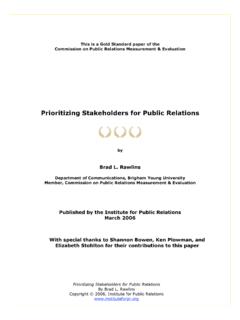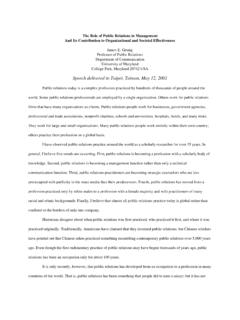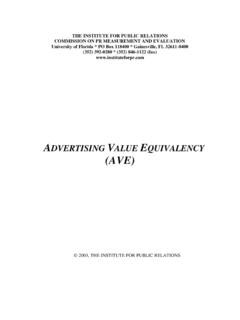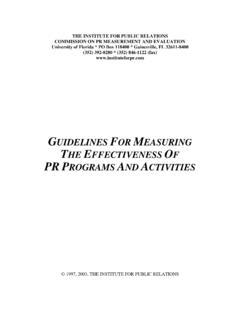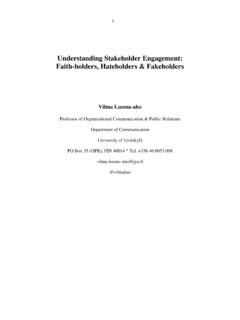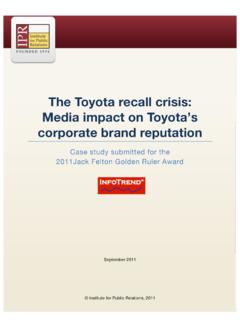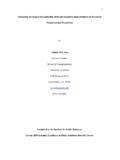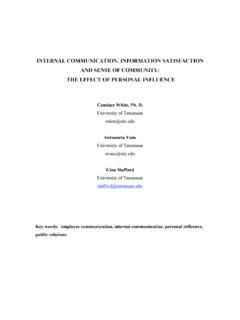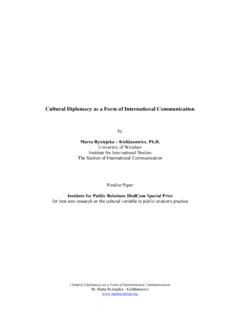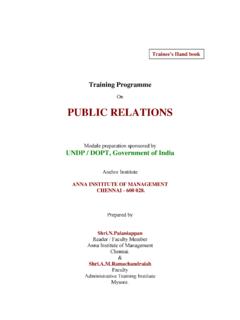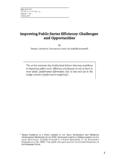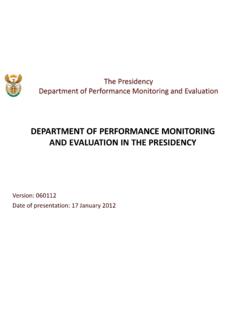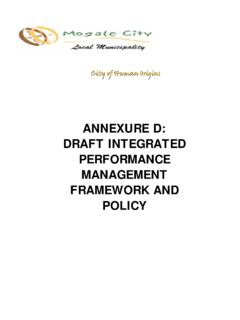Transcription of Guidelines for Measuring Trust 072905
1 Guidelines for Measuring Trust in Organizations, By Katie Delahaye Paine Copyright 2003 The Institute for public relations Guidelines for Measuring Trust in Organizations By Katie Delahaye Paine President, KDPaine & Partners Published by The Institute for public relations Guidelines for Measuring Trust in Organizations, By Katie Delahaye Paine Copyright 2003 The Institute for public relations 2 Guidelines for Measuring Trust in Organizations By Katie Delahaye Paine January 2003: A coalition of organizations representing 50,000 professional communicators gathered in New Jersey to discuss ways to restore Trust in American business. Buffeted by scandal and crisis since the Enron debacle, the average citizen s belief in the integrity and honesty of corporate American had reached an all-time low. The coalition agreed on three basic actions that they could recommend to each and every CEO in America.
2 1. The CEO should articulate a set of ethical principles closely connected to their core business processes and supported with deep management commitment, enterprise-wide discipline and training. 2. The CEO should create a process for transparency that is appropriate for current and future operations. It should include an oversight committee, culture audit and consistent messaging. CEOs should ensure that they have professional, competent counsel to serve as a strategic integrator, champion, bridge builder, catalyst, facilitator and record keeper for appropriate transparency. 3. The CEO should establish a formal system of measurement, measurement of Trust a business standard for that proved benchmarking and encouraging peer pressure and CEOs should make Trust a corporate governance issue and a board priority tied to compensation The first two are essentially process issues that are relatively easy to implement.
3 The third poses a problem to many corporations which has only been addressed by a few: How to measure Trust ? This document offers standard Guidelines to help professional communicators answer that question and implement the third directive of the PR Coalition. Guidelines for Measuring Trust in Organizations, By Katie Delahaye Paine Copyright 2003 The Institute for public relations 3 FOREWORD Trust or lack thereof, has a measurable impact on the financial health of an organization. Following the Enron scandal, its accounting firm, Arthur Anderson, was essentially destroyed because its clients lost confidence in its results. Sales of fast foods take a dive whenever news of tainted beef hits the airwaves causing consumers to question the safety of their favorite burger. Conversely, a key component to FedEx s success is customer confidence in the company s ability to deliver when it absolutely positively has to be there in the morning.
4 What is disturbing is that even though we intuitively know that Trust is important, we have yet to embrace a consistent methodology to measure the Trust of an organization. Companies have relied upon customer loyalty surveys or employee morale surveys to determine how people feel towards an organization, but there is little in the way of research that specifically focuses on Trust . We hope that with these Guidelines , organizations will agree with us that setting up a system to measure Trust in your organization is a critical component of corporate governance. Katie Delahaye Paine Chair IPR Commission on Measurement and Evaluation Guidelines for Measuring Trust in Organizations, By Katie Delahaye Paine Copyright 2003 The Institute for public relations 4 OVERVIEW One of the key action items coming from the Coalition summit in January was the need to have a single, unified approach to Measuring Trust .
5 Rather than force-fitting all programs into one system, The IPR Measurement Commission proposes a set of Guidelines that would recommend different measurement methodologies based on the type of organization seeking to measure its Trust . This document outlines our basic definitions of Trust , as well as Guidelines for its measurement. It is not intended to be a rigid set of criteria, but rather general Guidelines to ensure that we are all on the same page regarding the implementation of Trust measurement programs. First, we understand that it is impossible to impose a single definition and measure of a concept on everyone. Different researchers develop their own definitions of the same concept based on their unique theorizing. If everyone could be forced to define and measure a concept in the same way, we would lose the potential for innovation that science, in particular, and scholarship, in general, value highly.
6 In addition, we do not have the ability to impose a single definition and measure on everyone. Individual organizations have different constituencies, different objectives, different culture, and their communications practitioners will need to develop a unique product to measure Trust with their own constituencies. In the long run, we all benefit from this diversity of approaches because we can choose the approach that best fits our own needs. By taking the perspective that different system fit different organizations and situations, we believe that we will better accomplish our goals -- to encourage more companies to set up specific actionable and quantifiable systems for Measuring and improving Trust . DEFINITIONS: WHAT IS Trust ? Trust has been a widely studied concept both by itself but, most importantly, as a component of the quality of relationships.
7 In psychology and interpersonal communication, Trust has been one of several dimensions identified in relationships. It also has been studied extensively in business management and organizational communication sometimes as a single concept but, again, most often as a component of relationships. In psychology and communication, the emphasis has been on interpersonal relationships among spouses, friends, relatives, and the like. In business management and organizational communication, emphasis has been on relationships among managers and between managers and other employees. Only recently have public relations researchers began to use similar concepts to study organization- public relationships. The IABC document, Measuring Organizational Trust , and the Institute for public relations Guidelines for Measuring Relationships both contain extensive bibliographies that will be useful to any organization seeking to implement a Trust measurement program.
8 It is universally agreed that Trust is a multi-dimensional concept. It is: Multi-level: Trust results from interactions that span co-worker, team, organizational and inter-organizational alliances. Guidelines for Measuring Trust in Organizations, By Katie Delahaye Paine Copyright 2003 The Institute for public relations 5 Culturally-rooted: Trust is closely tied to the norms, values and beliefs of the organizational culture. Communication-based: Trust is the outcome of communications behaviors, such as providing accurate information, giving explanations for decisions and demonstrating sincere and appropriate openness. Dynamic: Trust is constantly changing as it cycles through phases of building, destabilization and dissolving. Multi dimensional: Trust consists of multiple factors at the cognitive, emotional and behavioral levels, all of which affect an individuals perceptions of Trust .
9 Has been one of several dimensions frequently included in measurement of relationships. Since its measurement is intrinsic to measurement of relationships, we include relationship definitions with our definitions of Trust . Trust dimensions include: Competence: The belief that an organization has the ability to do what it says it will do. It includes the extent to which we see an organization as being effective; that it can compete and survive in the marketplace. Integrity: The belief that an organization is fair and just. Dependability/Reliability: The belief that an organization will do what it says it will do; that it acts consistently and dependably. Openness and Honesty: This dimension involves not only the amount and accuracy of information that is shared, but also how sincerely and appropriately it is communicated. Vulnerability: The organization s willingness, based on its culture and communication behaviors in relationships and transactions, to be appropriately vulnerable based on the belief that another individual, group, or organization is competent, open and honest, concerned, reliable, and identified with common goals, norms, and values.
10 Trust is a complicated concept, which has several underlying dimensions. Concern for Employees: Concern for employees includes the feelings of caring, empathy, tolerance and safety that are exhibited when we are vulnerable in business activities. Sincere efforts to understand contribute to high levels in any relationships. Identification: Identification measures the extent to which we hold common goals, norms, values and beliefs associated with our organization s culture. This dimension indicates how connected we feel to management and to co-workers. Control mutuality: The degree to which parties agree on who has rightful power to influence one another. Although power imbalance is natural in organization: public relationships, unilateral attempts to achieve control by one party are associated with decreases in perceptions of communicator competence and satisfaction with the relationship and increases in the level of activism.
